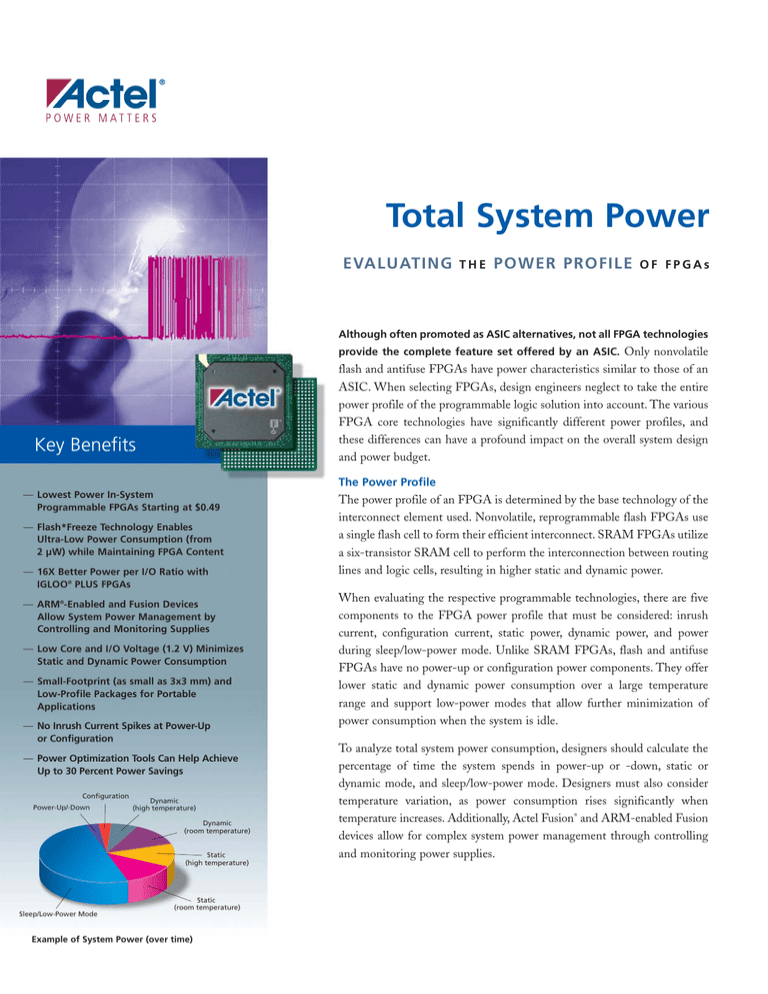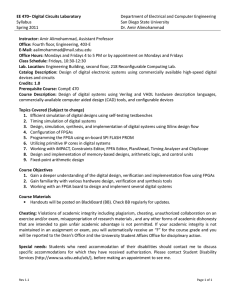
Total System Power
EVALUATING
THE
POWER PROFILE
OF FPGAs
Although often promoted as ASIC alternatives, not all FPGA technologies
provide the complete feature set offered by an ASIC. Only nonvolatile
flash and antifuse FPGAs have power characteristics similar to those of an
ASIC. When selecting FPGAs, design engineers neglect to take the entire
power profile of the programmable logic solution into account. The various
FPGA core technologies have significantly different power profiles, and
these differences can have a profound impact on the overall system design
and power budget.
Key Benefits
The Power Profile
— Lowest Power In-System
Programmable FPGAs Starting at $0.49
— Flash*Freeze Technology Enables
Ultra-Low Power Consumption (from
2 µW) while Maintaining FPGA Content
— 16X Better Power per I/O Ratio with
IGLOO® PLUS FPGAs
— ARM®-Enabled and Fusion Devices
Allow System Power Management by
Controlling and Monitoring Supplies
— Low Core and I/O Voltage (1.2 V) Minimizes
Static and Dynamic Power Consumption
— Small-Footprint (as small as 3x3 mm) and
Low-Profile Packages for Portable
Applications
— No Inrush Current Spikes at Power-Up
or Configuration
— Power Optimization Tools Can Help Achieve
Up to 30 Percent Power Savings
Configuration
Power-Up/-Down
Dynamic
(high temperature)
Dynamic
(room temperature)
Static
(high temperature)
Sleep/Low-Power Mode
Static
(room temperature)
Example of System Power (over time)
The power profile of an FPGA is determined by the base technology of the
interconnect element used. Nonvolatile, reprogrammable flash FPGAs use
a single flash cell to form their efficient interconnect. SRAM FPGAs utilize
a six-transistor SRAM cell to perform the interconnection between routing
lines and logic cells, resulting in higher static and dynamic power.
When evaluating the respective programmable technologies, there are five
components to the FPGA power profile that must be considered: inrush
current, configuration current, static power, dynamic power, and power
during sleep/low-power mode. Unlike SRAM FPGAs, flash and antifuse
FPGAs have no power-up or configuration power components. They offer
lower static and dynamic power consumption over a large temperature
range and support low-power modes that allow further minimization of
power consumption when the system is idle.
To analyze total system power consumption, designers should calculate the
percentage of time the system spends in power-up or -down, static or
dynamic mode, and sleep/low-power mode. Designers must also consider
temperature variation, as power consumption rises significantly when
temperature increases. Additionally, Actel Fusion® and ARM-enabled Fusion
devices allow for complex system power management through controlling
and monitoring power supplies.
Addressing Power Consumption
Power-Driven Layout
Typical IGLOO Power Distribution
Conventional Layout
Static
I/Os
Power Saved
SmartPower Power Analysis
Memories
Design
Nets/Clocks
FPGA Power
Gates
• Nets, Gates, I/Os, Memories, Array
• Power Supply Rail
• Clock Domains
• Component Instances
• Clock Cycles
• Switching Transitions
• Functional Modes
- Dynamic, Flash*Freeze, Static, Custom
Analysis Reports
Design Software
Libero® Integrated Design Environment (IDE) is Actel’s comprehensive
combination of active and semi-active modes, such as static, sleep,
software toolset for designing with all Actel FPGAs. Libero IDE
power-up, power-down, and Flash*Freeze for ProASIC3L and
performs design entry, synthesis, and simulation through
IGLOO designs. In addition to SmartPower’s traditional analysis of
floorplanning, place-and-route, timing constraints and analysis,
nets, gates, I/Os, clock domains, memories, supply rail, component
power analysis, and program file generation. Libero IDE easily
instances, and modes, SmartPower analyzes the power based on
manages the entire design flow and ensures maximum device
the total power consumption of the design measured over time.
performance and resource utilization.
SmartPower allows you to create a power profile for a design. The
Power Optimization with Libero IDE
While Actel FPGAs inherently use less power than competing
SRAM-based technologies, the power consumption of your Actel
flash design can be reduced significantly by using the wide array of
features in the Libero IDE tool suite.
Power-Driven Layout
Libero IDE offers a power-sensitive layout process that automatically
reduces the power consumption of a design as part of the place-androute process. By using a simulation Value Change Dump (VCD) file
or initialization from SmartPower, the dynamic power of Fusion,
IGLOO (IGLOO, IGLOO PLUS, IGLOOe), and ProASIC®3 (ProASIC3,
profile can be a combination of dynamic, static, Flash*Freeze, and
custom modes. The total power is reported based on the weighted
average of the power consumption of all modes. Consequently, a
more realistic report of power is provided.
Battery Life
The mode and profile analysis feature is taken to the next level with
the addition of a battery life estimator. Simply enter the proposed
battery capacity and SmartPower reports the estimated battery life
based on the mode or combination of modes in the power profile.
Battery choices and power profiles can be created to test different
configurations in order to create an optimal design.
ProASIC3L, ProASIC3E) designs can be reduced up to 30 percent
Libero Options
with little to no impact on timing performance.
Libero IDE is available for Microsoft® Windows® and RedHat® Linux
SmartPower Analysis
Today’s portable electronics typically do not spend 100 percent
of their “on” time in a fully powered-up mode. “On” time is a
operating systems, and has a number of license options including
free licenses.
1.25 A Inrush Spike
Actel FPGA Power Profiles
Voltage
The power profiles of both Actel’s nonvolatile (flash and
antifuse) FPGAs more closely resemble those of ASICs
and ASSPs than SRAM FPGAs. The power profile for
these device types is composed of only three significant
components: static, dynamic, and sleep/low-power
Actual SRAM FPGA Inrush Current
mode power.
Flash and antifuse FPGAs are live at power-up. They
retain their programming information once they have
Inrush Current
been configured, even after power-down. As a result,
there is no configuration cycle during power-up.
True flash FPGAs are the lowest-power full-featured
FPGAs on the market, with the lowest static and dynamic
power, and no inrush or configuration power.
Single-chip solutions are ideal for portable applications,
with the smallest form factor, Level 0 live at power-up,
and no power consumed by external devices.
SRAM FPGA
Nonvolatile FPGA
Power
Power-On Inrush
SRAM FPGAs
Operation,
FrequencyDependent
System
Supply
Voltage
Configuration
SRAM FPGAs
Time (or Frequency)
Sleep
Static
Dynamic
Static
rat
ure
Tem
pe
erat
Power
Sleep
Shutdown
SRAM FPGA
Nonvolatile
FPGA
p
Tem
Reconfiguration
ure
Stopped
Clock
Stopped
Clock
Time (or Frequency)
SRAM or “hybrid” SRAM FPGAs typically power up in an
unconfigured state. Until the device completes the initial
power-up and reset sequence, the various configuration bits are
in unknown states. As these bits are initialized each time power
is cycled, a current surge is created that may generate a spike as
high as several amperes. This event may also last as long as a few
hundred microseconds—all during the time the power supply is
ramping up and the rest of the system is attempting to power up.
To mitigate this current spike, many SRAM FPGAs have
added complex power sequencing requirements to the system.
This results in added design complexity and cost. Actel FPGAs
do not exhibit an inrush current spike due to their flash and
antifuse technology advantages.
1,000
Voltage
Configuration
Current
Static Power (mW)
SRAM FPGA at 70ºC
100
SRAM FPGA at 25ºC
10
1
Flash FPGA at 70ºC
0.1
Flash FPGA at 25ºC
0.01
100
1,000
10,000
100,000
Logic Count
Actual SRAM FPGA Configuration Current
Comparison of Static Current at Room and High Temperature
between Flash and SRAM FPGAs
Configuration Current
Static Power
After an SRAM or “hybrid” SRAM FPGA has completed its
initial power-up and reset, it must also be configured. During
configuration, a bitstream is downloaded to the device and the
various configuration bits are programmed. This configuration
programming can often consume hundreds of milliamps and
last for hundreds of milliseconds.
Static power is the minimum power required to maintain a
device in user mode while the I/Os and logic cells are not
switching. SRAM FPGAs consume significantly more static
power than do their flash and antifuse counterparts. At room
temperature, this difference may be tens of milliamps; at higher
operating temperatures, the difference can exceed hundreds of
milliamps. This higher current draw drastically impacts the
operating life of any battery-supplied system.
Flash and antifuse FPGAs are live at power-up. They retain their
programming information once they have been configured,
even after power-down. As a result, there is no configuration
cycle during power-up.
The Actel IGLOO device allows for ultra-low power
consumption while the IGLOO device is completely functional
in the system by maintaining I/Os, SRAM, registers, and logic
functions. This enables the IGLOO device to control the system
power management based on external inputs (e.g., scanning for
keyboard stimulus) while consuming minimal power.
Actel’s IGLOO PLUS I/O–optimized FPGAs offer up to 64
percent more I/Os than IGLOO FPGAs and are best suited for
I/O–intensive designs. IGLOO PLUS FPGAs consume 16X
less static power per I/O compared to their nearest competitor.
0.7
Power (µW) per I/O, 30 k Gates
The configuration current can prove especially lethal to
battery-based supplies, where constant loads are desirable to
maximize battery life. This operating characteristic of SRAM
FPGAs generally makes them poorly suited for portable
applications where battery life is a concern.
0.6
0.5
0.4
0.3
0.2
0.1
0
Competitor A
Competitor B
IGLOO PLUS
125
60
Dynamic Power (mW)
µW of Comparable Devices
70
50
40
30
20
Flash FPGA
SRAM FPGA
Hybrid SRAM FPGA
100
75
50
25
10
0
0
Flash FPGA
Hybrid SRAM CPLD
Low-Power CPLD
Design 1
Design 2
Design 3
Design 4
Design 5
Design 6
Design 7
Comparison of Sleep/Low-Power Mode Power between
Low-Power FPGAs/PLDs (µW of comparable devices)
Comparison of Dynamic Power between Flash and
Competing SRAM FPGAs
Sleep/Low-Power Mode Power
Dynamic Power
To further reduce power consumption in the system,
especially when idle, a few PLD vendors have implemented
low-power modes that can lower static power to below 1 mA.
SRAM FPGAs lose their configuration and data while in
sleep mode and therefore require reconfiguration, which
takes hundreds of milliseconds and consumes configuration
power. Flash FPGAs offer low-power modes that can be
controlled using internal or external signals, and can be put to
sleep and woken up after a predefined time.
Dynamic power is the power consumed when both the I/Os
and the logic cells are switching, and is a function of
capacitance, operating voltage, and switching frequency. If we
look at the dynamic power contribution alone, all advanced
FPGA technologies exhibit similar performance; however, the
dynamic power also contains the static power consumption
component. SRAM FPGAs consume more power under
static conditions and at high temperatures than flash and
antifuse FPGAs; therefore, the overall dynamic power
consumed by SRAM FPGAs is significantly higher.
Fusion and ARM-enabled Fusion devices allow system
power management by controlling and monitoring supplies.
Flash*Freeze technology used in Actel IGLOO and
ProASIC3L devices enables easy entry to and exit from ultralow-power mode, which consumes as little as 2 µW while
retaining SRAM and register data. Flash*Freeze technology
simplifies power management through I/O and clock
management without the need to turn off voltages, I/Os, or
clocks at the system level.
Actel IGLOO and ProASIC3L low-power FPGAs operate
from a 1.2 V core, and consume 30 percent less static power and
over 50 percent less dynamic power than 1.8 V “low-power”
PLD alternatives.
Dynamic power optimization is possible using a push-button
Power-Driven Layout, part of Actel Libero IDE. The ability
to place the device in or out of Flash*Freeze mode can reduce
dynamic power when the FPGA is not switching, even for a
short time.
Actel
When Power Matters
Flash FPGA
Flash FPGA
Low-Power
CPLD
SRAM FPGA
SRAM FPGA
SRAM
Hybrid FPGA
Calculated with 95% Idle and
5% at 100 MHz Operation
SRAM
Hybrid FPGA
0
500
1,000
1,500
2,000 2,500 3,000
Battery Life (hours)
3,500
4,000
Calculated with 50% Idle and
50% at 100 MHz Operation
Low-Power
CPLD
0
4,500
50
100
150
200
250
300
Battery Life (hours)
350
400
450
500
Battery Life per Device, Based on Vendor Software Power Analysis Tool
Total System Power
Summary
Unlike flash and antifuse FPGAs, SRAM FPGAs are not
single-chip. They require additional support devices to function
properly. In addition to the on-board memory devices needed to
store the configuration bitstreams, a CPLD is frequently needed
to act as a configuration controller. Additional circuitry is often
required to trap brownouts and power glitches to properly reset
and reconfigure the FPGA. Aside from the added board space and
cost of these components, each adds to the overall power profile
of the SRAM FPGA solution and makes system power-up
more complex.
FPGA technologies differ widely in their power consumption
characteristics. Both flash and antifuse FPGAs are true live-atpower-up technologies that do not exhibit large inrush current
spikes at power-up. Moreover, because Actel FPGA
technologies are nonvolatile, they do not suffer from the high
configuration current needed during each power cycle.
Additionally, Fusion devices allow for cost-effective system
power management by controlling and monitoring power
supplies for total system power considerations at the board level.
All FPGA solutions from Actel are single-chip and do not require
any external components to operate. This aspect not only leads to
reduced power consumption but also to a smaller overall footprint.
Actel low-power FPGAs lead the industry with lowest static and
dynamic power, best power per I/O, selection of power modes,
and small-form-factor packages for reduced manufacturing.
The nature of the SRAM FPGA power profile can force system
designers to unnecessarily oversize system power supplies and
complicate the overall design. Actel FPGAs exhibit a power
profile similar to that of ASICs and ASSPs, greatly reducing the
demand on power supplies and simplifying the designer’s task.
Flash technology provides the right mix of features to answer the
low-power market need: low power consumption in all modes,
availability of ultra-low-power sleep modes and Flash*Freeze
technology, reprogrammability to allow easy prototype and field
upgrades, a true single-chip solution, high system integration,
superior design security protection, small form factor packages,
I/O–optimized FPGAs, and the lowest total system cost.
Actel IGLOO devices can provide ten times the battery life of
their nearest low-power competitor. This is due to the overall
power profile and lower power consumption in all five stages of
system operation.
For more information regarding the Power Profile of Actel FPGAs, please contact your local Actel sales representative.
www. actel. com
Actel Corporation
Actel Europe Ltd.
Actel Japan
Actel Hong Kong
2061 Stierlin Court
Mountain View, CA
94043-4655 USA
Phone 650.318.4200
Fax 650.318.4600
River Court, Meadows Business Park
Station Approach, Blackwater
Camberley Surrey GU17 9AB
United Kingdom
Phone +44 (0) 1276 609 300
Fax +44 (0) 1276 607 540
EXOS Ebisu Building 4F
1-24-14 Ebisu Shibuya-ku
Tokyo 150, Japan
Phone +81.03.3445.7671
Fax +81.03.3445.7668
http://jp.actel.com
Room 2107, China Resources Building
26 Harbour Road
Wanchai, Hong Kong
Phone +852 2185 6460
Fax +852 2185 6488
www.actel.com.cn
© 2008 Actel Corporation. All rights reserved. The Actel name and logo are trademarks of Actel Corporation. All other trademarks and service marks are the property of their respective owners.
Printed on recycled paper
55700015-5/3.08




